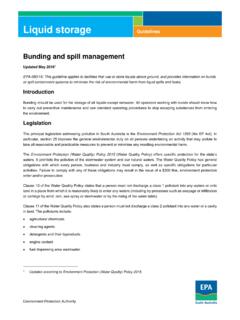Transcription of A Case Study of Pasir Gudang Chemical Toxic Pollution: A ...
1 Mal J Med Health Sci 16(SUPP11): 175-184, Nov 2020175 Malaysian Journal of Medicine and Health Sciences (eISSN 2636-9346)REVIEW ARTICLEA Case Study of Pasir Gudang Chemical Toxic pollution : A Review on Health Symptoms, Psychological Manifestation and Biomarker Assessment Sharifah Norkhadijah Syed Ismail1, Emilia Zainal Abidin1, Irniza Rasdi1 1 Department of Environmental and Occupational Health, Faculty of Medicine and Health Sciences, Universiti Putra Malaysia, 43400 Serdang, SelangorABSTRACTI ntroduction: This paper provides an overview of Chemical Toxic pollution in Pasir Gudang industrial area Johor Malaysia.
2 It discussed the health symptoms, argument of the psychology manifestation among children and the application of biomarkers and monitoring systems in Chemical detection. Methods: The systematic search was conducted for four digital scientific journal databases: Science Direct, SCOPUS, PubMed and Google Scholar with a specified keyword. Results: Seven (7) chemicals were related to this incident namely; Methane, Hydrogen chloride, Acrylonitrile, Acrolein, Benzene, Xylene, and Methyl mercaptan. These chemicals are mainly generated from industrial activity and easily breakdown through interaction with other chemicals and sunlight.
3 Inhalation is the major route of exposure and the major symptoms of these chemicals are headache, nausea, vomiting, breathing difficulties, eye irritation, chest tightness, and wheezing. There is no clear evidence to indicate that the victims in this incident are having a psychological manifestation since all chemicals involved are proven to cause the reported symptoms. Conclusion: Industrial chemicals are potential to produce Toxic gas in the air through reaction with other substances or rays and causes acute health symptoms.
4 Diagnose all post-emergency illnesses including mental and physical health is needed. Biomarker testing should consider a specified period after exposure occurs as the reactivity of some types of Chemical and its short half-life, rendered limited for use as markers of exposure in the : Toxic Chemical , Industries, Biomarker, Health, ChildrenCorresponding Author: Sharifah Norkhadijah Syed Ismail, PhDEmail: +603-9769 2857 INTRODUCTIONI ndustrial Toxic chemicals mainly exhibit reactive characteristics, ignitability, corrosive and Toxic . These Toxic chemicals can be in a form of physical states such as gaseous, liquids or solids.
5 It can be a byproduct of the manufacturing process or discarded commercial products such as cleaning fluids. Malaysia Environmental Quality Act 1974, Environmental Quality (Scheduled Wastes) Regulations 2005, has classified industrial Toxic chemicals waste as scheduled waste. Five main types of scheduled wastes under this regulation, consist of metal and metal-bearing wastes (SW1), inorganic constituents (SW2), organic constituents (SW3), waste contain either inorganic or organic constituents (SW4) and other wastes (SW5). Unlike domestic waste, this type of waste required a specific method of pre-treatment before being disposed of.
6 Industrial Toxic chemicals can pollute the environment and also harmful to human health especially to vulnerable groups such as children, elderly and pregnant mothers. Children are more susceptible to chemicals exposure through inhalation as compared to adults as their thin airways are more sensitive to the inflammation effects (1). Many research highlight the relationship between health and Chemical poisoning. For example, industrial chemicals such as organochlorine compounds (OCs) in herbicides may accumulate in the food chain and mainly stored in the adipose tissue.
7 When the fat tissues are metabolized, the Chemical will become biologically available. Humans are exposed primarily through the food consumption of the high-fat animal goods from fish, meats, and poultry foods (2). Endocrine-disrupting chemicals of organochlorine compounds (OCs) such as Dioxin-like compounds (DLCs) and nondioxin-like pcbs (NDL- pcbs ) may disrupt the hormonal process in the body and affect the development and reproductive systems (3, 4). This may increase diabetes and cardiac disease (5). Previous studies also indicated children who are exposed to organochlorines, are at greater risk for reducing in poor somatic growth, high BMI and 176 Malaysian Journal of Medicine and Health Sciences (eISSN 2636-9346)Mal J Med Health Sci 16(SUPP11): 175-184, Nov 2020neurobehavioral decrements (6, 7).
8 This may increase the risk of behavioral disorders or cognitive deficits among children (8). A significant episode of Toxic Chemical pollution incidents affecting thousands of people has been reported in the literature. Examples of Chemical incidents occurring worldwide started in 1976 and among the two biggest incidents was in Seveso, Italy, and Bhopal tragedy in India (9). The incident in Seveso, Italy was related to the release of airborne dioxin in the manufacturing plant and the consequences were related to many thousands of animal deaths, however, no immediate human deaths were recorded.
9 The incident that occurred in Bhopal was related to the release of methyl isocyanate which leaks from a tank at the Union Carbide factory which causes 3,800 immediate deaths, at least 15,000 premature deaths and caused Chemical exposure to almost 500,000 people (9).The incident of Toxic Chemical pollution in Pasir Gudang industrial area Johor Malaysia in 2019 has affected more than 5000 people, mainly children with respiratory symptoms such as breathing difficulties, nausea, and vomiting after breath in the poisonous gases.
10 It was reported that these children were having a manifestation of psychology due to anxiety about Chemical exposure (10). However, there is no clear evidence to prove this argument. Besides, the Chemical exposure was unable to be detected in the children s urine and blood biomarkers (11). This paper aimed to Study the characteristic of the chemicals related to this incident and the cause of health symptoms. This answers the argument about psychology manifestation among children as reported. The concept of a biomarker in Chemical detection were also highlighted in this paper to answer of why the chemicals cannot be detected by the biomarker.






